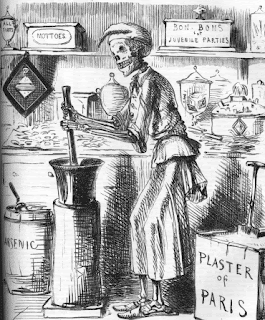 |
| Punch parody of sweet making in Victorian Britain. |
One Monday in October, 1858, Mr Neal sent
his assistant to buy a quantity of plaster of Paris from the druggist. The
reason? It was much cheaper than sugar and could be used as 'daft' or an inexpensive
substitute to bulk up sweets. The assistant called on
the chemist, who sent his apprentice to the cellar, where he weighed out twelve
pounds of daft. Unfortunately, the new assistant measured out and mistakenly
sold him the wrong white powder - arsenic. This deadly poison was taken back to
the sweet shop where it was incorporated into peppermint drops - which killed
twelve people and made over a hundred seriously ill.
 |
| Victorian Bradford - where Joseph Neal had his sweet shop. |
 |
| Peppermint creams. |
It was said that merchants were so driven
by money that:
"the
possible sacrifice of even a fellow creature's life is a secondary
consideration."
In the 1820's the German chemist, Friedrich
Accum took on a person crusade to stop food adulteration, the practice being so
widespread:
"There
is death in the pot."
 |
| Even bread and cheese commonly contained adulterants. |
Even before Accum, in the 1790's an article in The Tatler warns about a:
"Fraternity
of chemical operators, who work undergrounds…hidden from view…transmuting base
ingredients [sub standard wine]…into the choicest products of the hills and
valleys of France
They did this by adding alum (to brighten
colour) gypsum (to remove cloudiness) and sugar of lead (to counteract
acidity). Not only that, but they often used bottles bought from pedlars who in
turn had bought them from druggists who had previously used them to store
arsenic!
Interestingly, one victim of adulterated
wine was Francis Blandy (see Part One), when he partook of tainted wine in the
Red Lion, Henley. His two drinking companions died; whilst he survived (He was
later poisoned by his daughter who thought she was giving him 'forgiveness
powder.')
You would have expected the Victorian parliament to bring in rigorous laws, prohibiting the use of food adulteration - but not a bit of it! On the one side a public outcry led to an anti-adulteration bill being put before the House of Commons in 1857, but it was voted down, as was a similar bill in 1859. Oratory denounced the legislation as interference, that it:
"Treated
the people of this country like children"
In other words, people could make their own
decisions about what they bought and if might harm them - much like fast food
today?
"Soon
government would have such power as even to lay down the proportion of water a
man might put in his grog."
Echoes of rebellion against the modern
'Nanny' state?
 |
| Additives? What additives? |




















